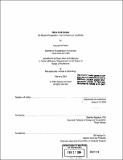| dc.contributor.advisor | Takehiko Nagakura. | en_US |
| dc.contributor.author | Kwon, Kyoung Eun, 1974- | en_US |
| dc.contributor.other | Massachusetts Institute of Technology. Dept. of Architecture. | en_US |
| dc.date.accessioned | 2005-09-26T19:48:09Z | |
| dc.date.available | 2005-09-26T19:48:09Z | |
| dc.date.copyright | 2004 | en_US |
| dc.date.issued | 2004 | en_US |
| dc.identifier.uri | http://hdl.handle.net/1721.1/28326 | |
| dc.description | Thesis (M. Arch.)--Massachusetts Institute of Technology, Dept. of Architecture, 2004. | en_US |
| dc.description | Includes bibliographical references (p. 82-83). | en_US |
| dc.description.abstract | This thesis is an inquiry into the potential of film as an extended perspective defined by the sequential juxtaposition of images. Based on the notion that linear perspective in Renaissance architecture was used as a formal tool for the poetic imagination, it is assumed that motion perspective used as a design tool would have a formative influence on the architectural design process and thence, on the final product, architectural space and the sequence of spaces. The project uses film theory as the conceptual framework from which to gain a better understanding of the fourth dimension (time) in the creation of architecture. Cinematic camera movements, which already have a syntax or patterned language are modified for defining specific geometries in the creation of built space. The program consists of a housing block and community center in East Boston, offering a variety of spatial types for experimentation. In the primary analysis, the site is observed through a series of camera sequences. In the design process these camera movements are used to generate a spatial geometry based on the relationship between camera and filmed space. For instance, the housing has a layered spatial configuration corresponding to the tracking shot used in the site analysis. Computer generated motion graphics (4-D motion perspective) are used in each step of conceptual design. A dialectic of observation and form-generation with camera sequences are repeated throughout the building using the syntax of other movie-based sequences. The thesis demonstrates the potential of cinematographic sequencing in architectural design, moving beyond the three-dimensional scenography of traditional perspective. | en_US |
| dc.description.statementofresponsibility | by Kyoung Eun Kwon. | en_US |
| dc.description.tableofcontents | Titles from disk: Forest of light -- Jungle steps -- East Boston Project. | en_US |
| dc.format.extent | 84 p. | en_US |
| dc.format.extent | 3460172 bytes | |
| dc.format.extent | 3470025 bytes | |
| dc.format.mimetype | application/pdf | |
| dc.format.mimetype | application/pdf | |
| dc.language.iso | en_US | |
| dc.publisher | Massachusetts Institute of Technology | en_US |
| dc.relation.requires | DVD-ROM. | en_US |
| dc.rights | M.I.T. theses are protected by copyright. They may be viewed from this source for any purpose, but reproduction or distribution in any format is prohibited without written permission. See provided URL for inquiries about permission. | en_US |
| dc.rights.uri | http://dspace.mit.edu/handle/1721.1/7582 | |
| dc.subject | Architecture. | en_US |
| dc.title | Filmic architecture : on motion perspective in architectural synthesis | en_US |
| dc.type | Thesis | en_US |
| dc.description.degree | M.Arch. | en_US |
| dc.contributor.department | Massachusetts Institute of Technology. Department of Architecture | |
| dc.identifier.oclc | 55653651 | en_US |
